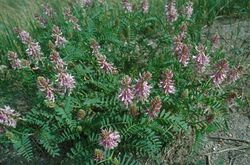Biology:Astragalus bisulcatus
| Astragalus bisulcatus | |
|---|---|

| |
| Scientific classification | |
| Kingdom: | Plantae |
| Clade: | Tracheophytes |
| Clade: | Angiosperms |
| Clade: | Eudicots |
| Clade: | Rosids |
| Order: | Fabales |
| Family: | Fabaceae |
| Subfamily: | Faboideae |
| Genus: | Astragalus |
| Species: | A. bisulcatus
|
| Binomial name | |
| Astragalus bisulcatus (Hook.) A.Gray, 1860
| |
Astragalus bisulcatus, commonly called two-grooved milkvetch or silver-leafed milkvetch, is a leafy perennial with pea-like flowers. It is native to central and western North America,[1] and typically grows on selenium-rich soils. It accumulates selenium within its tissues, and when livestock consume it, the selenium can be toxic.[2]
Description
Astragalus bisulcatus is a herbaceous perennial with a thick woody root-stock, growing 30 to 100 cm tall.[3] It has numerous simple stems and long pinnate leaves. The flowers are produced in narrow elongated racemes. The flowers are white or purple in color[4] and bloom in late spring and early summer. The seed pods characteristically are two grooved on the upper surface. The fruits ripen and release their seeds in July and August.[5] The seeds are dark brown or black, reniform in shape, 4 mm long and 2 mm wide.[3][6]
Selenium toxicity
Astragalus bisulcatus accumulates large quantities of selenium when grown on soils that have selenium, the plant produces amino acids where sulfur is replaced by selenium.[7] Most animals avoid Astragalus bisulcatus because of the musky odor of the dimethyl selenium compounds contained in the plants tissues.[8] Yet, sheep and cattle have indulged in eating the plant, becoming victims of selenium toxicity. Sheep can die in thirty minutes from eating a half a pound of Astragalus bisulcatus, and in 1907 and 1908, approximately 15,000 sheep in Wyoming died with symptoms of either alkali disease or the blind staggers; both of which were outcomes of digesting a large amount of selenium from Astragalus bisulcatus.[9]
References
- ↑ "USDA Plants Database". http://plants.usda.gov/java/profile?symbol=ASBI2.
- ↑ "Notes on poisoning: Astragalus bisulcatus". Government of Canada. 2009-09-01. http://www.cbif.gc.ca/pls/pp/ppack.info?p_psn=26&p_type=all&p_sci=sci. Retrieved 2010-04-07.
- ↑ 3.0 3.1 New York Botanical Garden (1919). North American flora. New York Botanical Garden. pp. 281–. https://books.google.com/books?id=xEw9AAAAIAAJ&pg=PA281. Retrieved 26 September 2010.
- ↑ Taylor, Ronald J. (1994) (in en). Sagebrush Country: A Wildflower Sanctuary (rev. ed.). Missoula, MT: Mountain Press Pub. Co. pp. 100. ISBN 0-87842-280-3. OCLC 25708726. https://www.worldcat.org/oclc/25708726.
- ↑ United States. Division of Botany (1901). Bulletin. Govt. print. off.. pp. 148–. https://books.google.com/books?id=gHJWAAAAMAAJ&pg=PA148. Retrieved 26 September 2010.
- ↑ "Southwest Colorado Wildflowers, Astragalus bisulcatus". https://www.swcoloradowildflowers.com/White%20Enlarged%20Photo%20Pages/astragalus%20bisulcatus.htm.
- ↑ Galston, Arthur: Green Wisdom. Basic Books, Inc.. 1981. p. 40. ISBN 978-0465027125. https://archive.org/details/greenwisdom00gals/page/40.
- ↑ "Cornell University Department of Animal Science: Plants Poisonous to Livestock". Cornell University. 2009-03-26. Archived from the original on 22 August 2010. https://web.archive.org/web/20100822183813/http://www.ansci.cornell.edu/plants/locoweed/se2.html. Retrieved 2010-09-26.
- ↑ Galston, Arthur: Green Wisdom. Basic Books, Inc.. 1981. ISBN 978-0465027125. https://archive.org/details/greenwisdom00gals.
Wikidata ☰ Q2868505 entry
 |

